Bohemian National Cemetery: the bronzes
Wikipedia tells us that "Bohemian" came to mean "artsy non-conformist" in 19th Century Paris because Parisians assumed that their local gypsies came from Bohemia -- but I have another theory: it's that Czechs actually are artsy non-conformists -- at least -- that applies to so many of the ones that I've known.
And it especially applies to Chicago's Bohemian National Cemetery because it has the largest collection of life-size sculpture in Chicago (and maybe the U.S.) -- with, by my guess, over 200 such pieces.
The ones that I liked the most were the bronzes -- and here they are (there weren't very many -- and I think I liked them all)



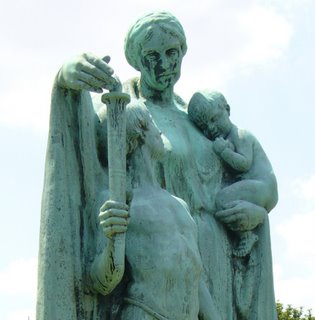
Pride of Place in this exhibit (right in front of the crematorium) goes to Albin Polasek, the Czech born prodigy who won the American Prix de Rome and came to Chicago to teach at the Art Institute for about 40 years. He reminds me a lot -- and is almost an exact contempory of -Paul Landowski -- for that struggle between monumentality and naturalism - where, regrettfully, the naturalism comes out on top. So the pieces draw admiration -- but shouldn't they be in a Museum of Natural History ? Maybe I just don't want a joyous theme (mother and children) turned into a somber one.



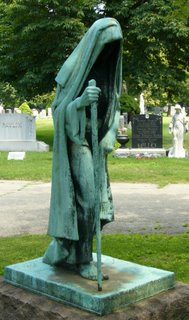


Here's another Polasek piece,"Walking Death" -- apparently a response to "Eternal Silence" made by his predecessor at the Art Institute,Laredo Taft.
As posted a few weeks ago, I feel that the Taft piece is something of a hoot that belongs in a carnival fun house -- but the Polasek piece really does feel creepy to me -- especially from a distance -- where the figure apears to be walking towards her next victim. Now why Death would be stalking a graveyard is a mystery to me -- wouldn't she find more opportunities in someplace like, say, a nursing home ?
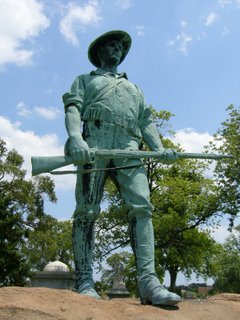
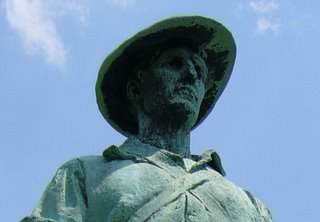
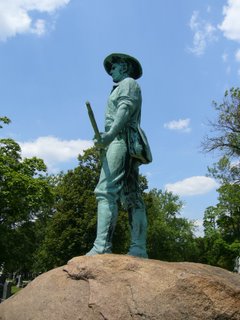
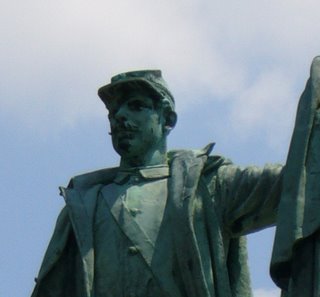
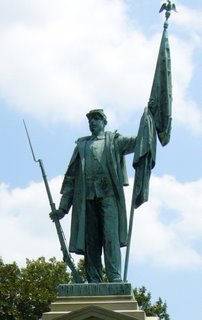
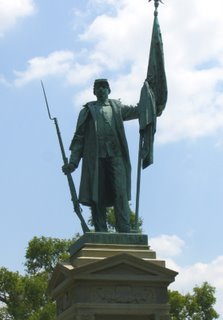

Now we come to the war monuments (Spanish-American and Civil) -- and, actually, I think these statues are very good -- especially the front view (and face !) of the Spanish-American War soldier -- and the back view of the Union soldier. Something feels so essentially/ideally American about them.
But why are the sculptors' names not listed on the pedastal ? (Now I appreciate why Louis T Rebisso put his name in 8" letters on the base of his Grant equestrian)
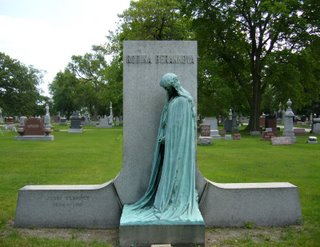
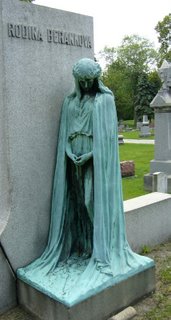
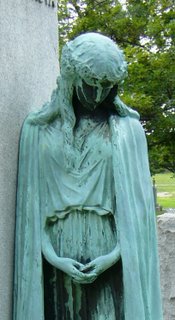
And here's another anonymous sculptor - and very good one. I don't think any living sculptor could design a better monument than this one.
And it especially applies to Chicago's Bohemian National Cemetery because it has the largest collection of life-size sculpture in Chicago (and maybe the U.S.) -- with, by my guess, over 200 such pieces.
The ones that I liked the most were the bronzes -- and here they are (there weren't very many -- and I think I liked them all)




Pride of Place in this exhibit (right in front of the crematorium) goes to Albin Polasek, the Czech born prodigy who won the American Prix de Rome and came to Chicago to teach at the Art Institute for about 40 years. He reminds me a lot -- and is almost an exact contempory of -Paul Landowski -- for that struggle between monumentality and naturalism - where, regrettfully, the naturalism comes out on top. So the pieces draw admiration -- but shouldn't they be in a Museum of Natural History ? Maybe I just don't want a joyous theme (mother and children) turned into a somber one.






Here's another Polasek piece,"Walking Death" -- apparently a response to "Eternal Silence" made by his predecessor at the Art Institute,Laredo Taft.
As posted a few weeks ago, I feel that the Taft piece is something of a hoot that belongs in a carnival fun house -- but the Polasek piece really does feel creepy to me -- especially from a distance -- where the figure apears to be walking towards her next victim. Now why Death would be stalking a graveyard is a mystery to me -- wouldn't she find more opportunities in someplace like, say, a nursing home ?







Now we come to the war monuments (Spanish-American and Civil) -- and, actually, I think these statues are very good -- especially the front view (and face !) of the Spanish-American War soldier -- and the back view of the Union soldier. Something feels so essentially/ideally American about them.
But why are the sculptors' names not listed on the pedastal ? (Now I appreciate why Louis T Rebisso put his name in 8" letters on the base of his Grant equestrian)



And here's another anonymous sculptor - and very good one. I don't think any living sculptor could design a better monument than this one.


2 Comments:
I love those sculptures--the one of death really is creepy. I love those soldier's monuments as well. Thanks, Chris. Let me know next time you go there. I'd like to see it.
yes, this last angel is a beauty. under the influence of mounthang, im starting to photograph statuary... its really difficult to do it justice. in bali i could only take decent photos in the early morning light, otherwise they come out all flat. ill send you some photos today.
Post a Comment
<< Home